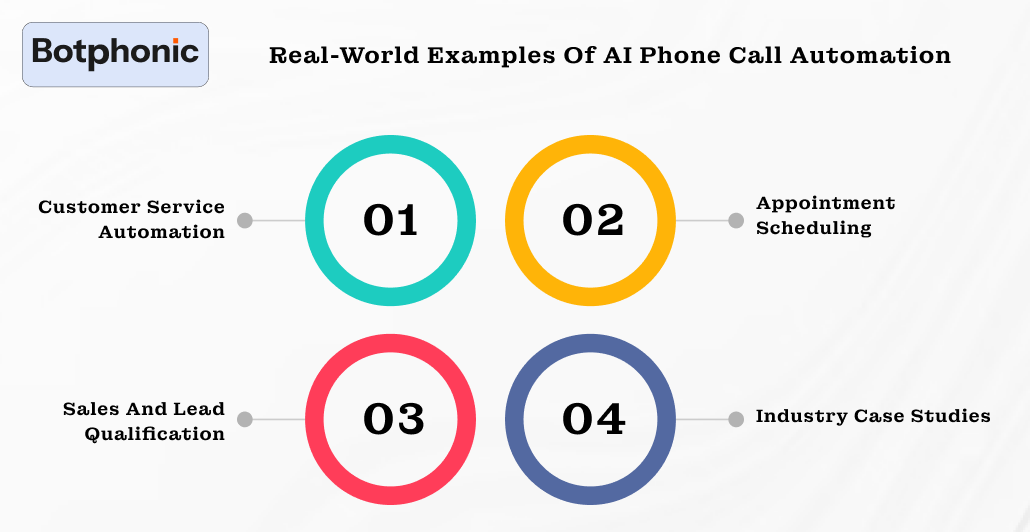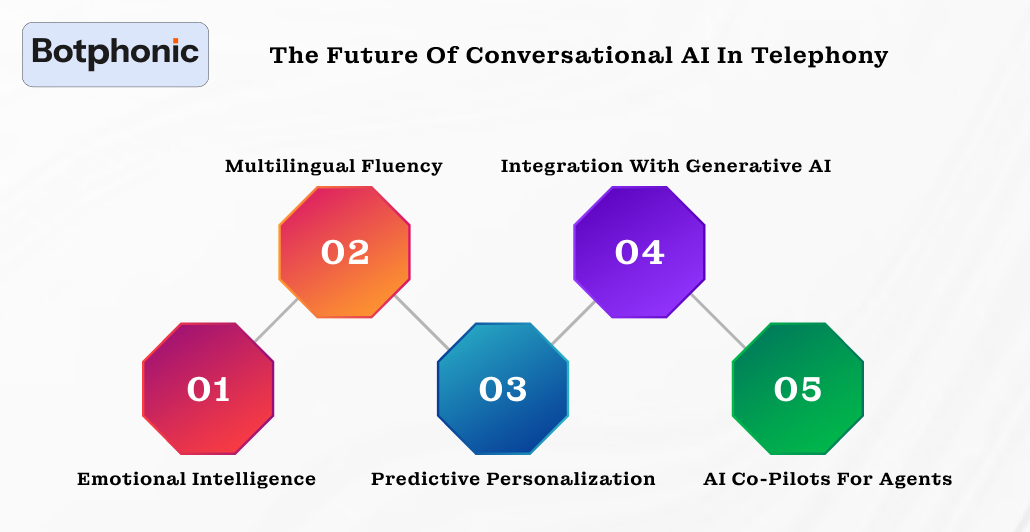
Summarize Content With:
Quick Summary
Artificial intelligence has revolutionized phone-based customer interactions. Systems are not designed to manage the appointment schedules, log the details into CRM, and respond to queries automatically. With seamless integration with CRM and other enterprise tools, the outcomes are much better than expected. It provides faster responses, reduced operational costs, and exponentially improved customer experience.
In this article, we will be uncovering the AI phone call system architecture. We will discover how AI phone calls work and what its core architecture system is that makes it run. With real-world examples and the future outlook of conversational AI in telephony.
Introduction
Artificial intelligence is no longer just about the chatbot anymore, but it has started answering calls, booking appointments, and integrating the data into CRM.
The evolution of IVR from pressing those frustrating numbers to modern AI phone call systems that use conversational AI to understand natural speech and hold on to meaningful conversations. Thinking about the result you will get, it is obviously the faster response times, reduced costs, and a smoother experience for their clients.
When fast-forwarding to today’s era, AI has now given voice communication a serious upgrade. Modern AI phone call systems are using conversational AI to understand natural speech and carry on meaningful conversations while automating routine inquiries.
Uncovering the AI Phone Call System
Businesses, from small service providers to Fortune 500 enterprises, are adopting AI call assistants so they can handle tasks that initially required a full human team. Unlike the stiff and direct scripts of traditional systems, today’s conversational AI can identify the user’s intent, adjust their tone, and then respond. An AI phone call system works by talking, listening, understanding, and responding to callers naturally. At its core, the system typically relies on numerous advanced technologies that work together.
Instead of a human agent picking up the phone, an AI-powered voice assistant does all the talking, listening, acknowledging, and replying to callers naturally.
At its core, the system heavily relies on many advanced technologies working alongside each other.
- Speech Recognition (ASR): Transforming the voice of the caller into written words.
- Natural Language Processing (NLP): Processing the text to identify the intent, emotion, and context.
- Dialogue Management: Picking the appropriate reply according to the flow of conversation.
- Text-to-Speech (TTS): Making the AI’s text response sound like a human voice again.
System Integration: Integrating the AI with CRMs, scheduling applications, or databases so that it can access real-time information, such as appointment availability or account details.
How AI Phone Calls Work: Step by Step
Let’s start with uncovering the truth of what happens since the moment the call begins.
1. Voice Input
A caller speaks naturally; there are no requirements for specialized commands or prompts.
2. Speech-to-Text Conversion
The AI’s automatic speech recognition engine converts the shared audio into text within milliseconds.
3. Understanding Intent
Optimizing NLP, the system will now determine what the caller is expecting and will identify relevant details like time and service type.
4. Generating a Response
The AI will now select an appropriate response from the pre-added script or just generate one as required.
5. Voice Output
The system will now use TTS to share responses in a natural voice; it’s designed so that it’s often nearly indistinguishable from a human.
6. Data Handling
Each interaction made is getting logged into the system. Now, the system will learn from past calls, improving accuracy and tone over time.
And this is where the magic happens. Even though it’s an automated conversation, it’s intelligent, not just a rigid script.
The Core Architecture of an AI Phone Call System

Every seamless voice interaction is well-designed with an AI phone call architecture. Let’s see what the system actually looks like behind its mechanism.
1. Front-End Layer (The User Interface)
This layer is designed so that it handles everything that the caller is going to experience.
- Captures and digitizes the voice input.
- Filters the background noise and improves clarity effectively.
- Transcribes the speech into text accurately across different accents and languages.
This is where the caller gets a “feel human” experience. The smoother the front-end experience is, the more natural the AI seems.
2. Processing and Intelligence Layer (The AI Brain)
And from this part onwards, heavy-lifting starts. NLP models and other deep learning algorithms detect what callers are trying to convey. This layer includes:
- Intent Recognition: Detects the caller’s requirement.
- Entity Extraction: Pulls key details from the interactions, such as dates, names, or reference numbers.
- Dialogue Management: Looking for what to say next, based on context and conversation history.
This layer simply turns the voice into actionable intent.
3. Back-End Layer (Integration and Data Management)
Once AI has gotten a grasp of what to do, it will connect with the company’s systems:
- CRM for customer details.
- Scheduling software for appointments
- Payment gateways for transactions
- Databases for performing account verification
Data privacy and security are established at the core of this layer, ensuring compliance with standards like GDPR and HIPAA.
4. Cloud vs. On-Premise Infrastructure
Many AI phone systems these days are running on the cloud, which also allows them flexibility and scalability. Businesses are now able to process thousands of calls simultaneously without even requiring heavy hardware.
However, for enterprises that are prioritizing control or data security, on-premise solutions are viable for them. Since it offers greater oversight at the expense of scalability.
Real-World Examples of AI Phone Call Automation

AI phone call automation software no longer exists in theory; it’s already working across industries and proving its worth.
1. Customer Service Automation
Just think of calling your internet provider to ask, “Why is my internet slow?” Instead of a human, an AI system is present and diagnosing the issue, resetting the router remotely, and lastly confirming whether the connection is restored. You see, there’s no requirement for a human agent when AI alone can help you with this.
2. Appointment Scheduling
Appointment scheduling is one of the major tasks, whichever the industry. From healthcare to auto repair shops, AI assistants are handling scheduling tasks with ease. The AI syncs with a calendar system, confirms appointments, and even sends reminders to the caller regarding their visit.
3. Sales and Lead Qualification
With the emergence of AI, for sales teams as well, it has become easier to pre-screen leads. With friendly phone calls and a pre-qualified question dataset, it has become quicker to qualify potential leads. Here, AI records responses, scores leads, and only routes warm prospects to human agents. Meaning, it permits sales to focus only on converting leads rather than concentrating on cold calling.
4. Industry Case Studies
- Google Duplex: Demonstrated how AI can make restaurant or salon bookings seamlessly.
- Twilio Voice AI: Provides APIs for building voice automation into existing systems.
- Five9 & Kore.ai: Offer enterprise-grade call automation that blends AI and human agents.
Let Technology Handle the Routine so You Focus on People Who Matter
Try Botphonic Today!!The Future of Conversational AI in Telephony

The development of AI phone systems is going at a pace that is hardly believable. We are all experiencing the stream of innovations coming our way because of the improvements in Generative AI and LLMs (Large Language Models). Let’s take a look at some of the possible trends:
1. Emotional Intelligence
AI has been successful in recognizing and understanding emotions, and it is learning and adapting by detecting tone, sentiment, and even stress levels. The upshot of these improvements is that perhaps future installations would be conversant enough to speak softly, for instance, when the caller seems to be unhappy.
2. Multilingual Fluency
Artificial intelligence of today is not only able to process different languages, but also, the next milestone might be instantaneous translation, which makes it possible to support all over the world.
3. Predictive Personalization
AI using caller history can forecast a customer’s needs even before he/she say it. Imagine it like calling your band, and the system is welcoming you with: “Hello! Have you called to check the status of your loan?”
4. Integration with Generative AI
Bringing together conversational AI and generative language models empowers the system to produce responses that are more human and context-aware. The transition from “scripted bots” to AI that can reason and act independently is one of the major trends in the world today.
5. AI Co-Pilots for Agents
Telephone operators do take over a call, but AI is still there to assist through silent help. It can do so by providing live transcriptions of the conversations, offering responses, and then giving a summary of the entire interaction at the end.
Conclusion
AI phone call systems are operational realities, driving efficiency, personalization, and cost savings at scale. With AI phone call systems’ architecture in action, it’s enhancing the caller experience through accurate speech recognition and noise filtering. Moreover, its processing layers use NLP, intent recognition, and dialogue management. Whereas the back-end layer integrates with CRMs and schedulers, while maintaining compliance.
Businesses are now embracing the technology and moving from “managing calls” to “mastering conversations.” The future now belongs to organizations who is willing to fuse conversational AI with human empathy and create a seamless and intelligent voice interface. In the future outlook of an AI phone call agent, it might develop emotional intelligence that recognizes tone and sentiment. With multilingual and predictive capabilities, they will enable hyper-personalized conversations and global support.

